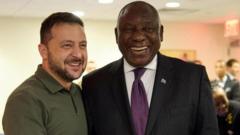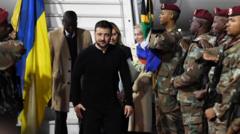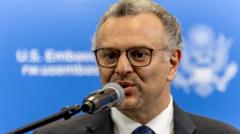President Trump’s recent condemnation of Ukraine's President Zelensky highlights tensions over a controversial U.S. peace proposal amid ongoing war with Russia.
**Trump's Ultimatum to Ukraine: The Risks of a Controversial Peace Proposal**

**Trump's Ultimatum to Ukraine: The Risks of a Controversial Peace Proposal**
In a bold move, President Trump urges Ukraine to reconsider a U.S. peace plan that sides with Russia, sparking significant backlash from Kyiv.
In a striking departure from previous U.S. diplomatic norms, President Trump publicly criticized Ukrainian President Volodymyr Zelensky after Zelensky rejected a U.S.-proposed peace plan that aligns closely with Russian interests. Trump asserted on social media that Zelensky faces a choice between accepting the proposal for peace or enduring extended conflict, stating, “He can have peace or he can fight for another three years before losing the whole country.”
Vice President JD Vance detailed the U.S. proposal, which entails freezing territorial lines, acknowledging Russia's 2014 annexation of Crimea, and a commitment that Ukraine would not pursue NATO membership. This announcement marks a pivotal shift, presenting a U.S. peace initiative that appears to favor Russian territorial ambitions.
The ultimatum created immediate friction, with Zelensky firmly rejecting Russia's claim to Crimea, which he insists violates Ukraine's Constitution. “There is nothing to talk about,” he emphasized in his rejection, reinforcing that the territory belongs to the people of Ukraine.
Accusing Zelensky of making "inflammatory" remarks, Trump questioned why Ukraine did not respond militarily when Crimea was annexed in 2014, implying that Zelensky’s statements could exacerbate the ongoing conflict. Trump warned that Zelensky’s stance would prolong the violence, which currently sees Russia occupying nearly 20% of Ukraine. The proposed freeze would effectively compel Ukraine to surrender significant portions of its territory to Russia.
The implications of this proposal are profound, raising questions about U.S. foreign policy direction and its impact on Ukraine's sovereignty as well as broader geopolitical stability in Eastern Europe.





















